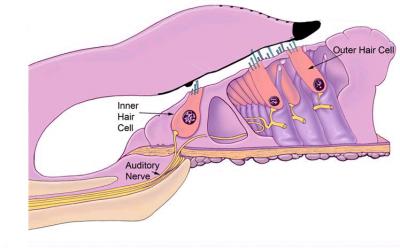It is important to understand the mechanics of how we hear. Sound waves enter the ear canal and cause the eardrum to vibrate. These vibrations are then transmitted through the middle ear to the inner ear, where they stimulate tiny hair cells that convert the sound energy into electrical signals that the brain can interpret as sound. The hair cells responsible for detecting low-frequency sounds are located at the bottom of the cochlea, the snail-shaped structure in the inner ear that houses the hair cells. These hair cells are more vulnerable to damage than those that detect higher frequencies, which are located closer to the entrance of the cochlea.

There are many reasons why these hair cells may become damaged, leading to hearing loss.
Aging
One of the most common causes is aging. As we get older, the hair cells in our ears naturally begin to deteriorate, and the cochlea becomes less flexible. This process, known as presbycusis, is a gradual one that usually affects both ears equally. However, the hair cells responsible for detecting low-frequency sounds tend to deteriorate more quickly than those that detect higher frequencies. This is why people with age-related hearing loss often have difficulty hearing low-pitched sounds, such as the rumble of a truck or the bass in music.
Loud Noise
In addition to aging, exposure to loud noise is another common cause of hearing loss. Prolonged exposure to sounds above 85 decibels (dB) can damage the hair cells in the inner ear, leading to hearing loss. This can happen in a variety of settings, such as at a rock concert, in a noisy workplace, or even while using headphones at a high volume. The hair cells that detect high-frequency sounds are usually the first to be damaged in cases of noise-induced hearing loss, but if the exposure is prolonged or intense enough, the low-frequency hair cells may also be affected.
Medications
Certain medical conditions and medications can also cause hearing loss. For example, Meniere’s disease, a disorder of the inner ear, can cause fluctuating hearing loss that often starts with low-frequency sounds. Ototoxic medications, such as some antibiotics and chemotherapy drugs, can also damage the hair cells in the inner ear, leading to hearing loss.
So why are low-frequency sounds more vulnerable to damage than higher frequencies? There are a few possible explanations. One theory is that low-frequency sounds cause more vibration in the cochlea, which can put more stress on the hair cells. Another possibility is that the low-frequency hair cells are simply more susceptible to oxidative stress, which can damage the cells’ DNA and proteins.
Regardless of the exact mechanism, the fact remains that low-frequency sounds are usually the first to go when people develop hearing loss, regardless of their age. This can have significant implications for communication, as many consonants in speech, such as “s” and “f”, are high-frequency sounds. Without these sounds, speech can become muffled and difficult to understand. It can also affect one’s ability to enjoy music, as the bass and drums, which provide the rhythm and foundation of many songs, are low-frequency sounds.
– RHIposthttps://rescuehearing.com/?p=8503

